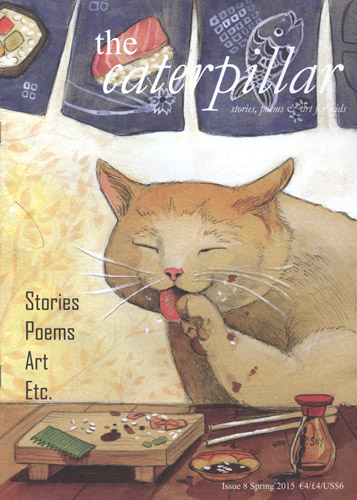The Caterpillar – Spring 2015
If you have young people in your life you want to inspire to read and write, The Caterpillar is your way to reach them. Published by the same folks who bring The Moth to young adult readers, The Caterpillar is geared toward an even younger crowd, the 7 – 11-ish range, which can be a tough group to target with the right amount of enjoyable silliness as well as seriousness for the more critical among them, but The Caterpillar gets the mix perfectly. If you have young people in your life you want to inspire to read and write, The Caterpillar is your way to reach them. Published by the same folks who bring The Moth to young adult readers, The Caterpillar is geared toward an even younger crowd, the 7 – 11-ish range, which can be a tough group to target with the right amount of enjoyable silliness as well as seriousness for the more critical among them, but The Caterpillar gets the mix perfectly.
For silliness, you need only open the cover to see Deidre Wicks’s (gorgeous) watercolor of a ballerina frog complete with toe shoes, a tutu and a tiara. The image accompanies a likewise silly poem by Julie Anne Douglas, “Fernando the Farting Frog.” Truly, try NOT reading this one out loud to a child! It’s utterly uproarious! Fernando finds that he can stave off crocodile attacks—and thus stay alive—thanks to his ability: “His farts wilted flowers. Birds dropped from the sky. / The smell was quite toxic, and no one knew why.”
The fun and the silly continue with poems reminiscent of Shel Silverstein, Jonathan Pinnock’s three, “The Sulphurous Sphygnum,” “The Limpopo Loon,” and “Bodrills.” But for all their silliness, there’s also some smart in these poems; the kind that implants itself in young minds to make them curious and explore what the writer was talking about. David Woolley’s “Monkey,” for example, is a reference to “Doctor Darwin’s theory.” If a young reader doesn’t already know about Darwin and the concept of evolution—seed planted. There’s also Bowman Wilker’s poem “Kit and Kaboodle – Attorneys at Law” which is a playground of language and animal metaphor, like “Cat got your tongue? / Bug got your lung? / Frog got your throat? / That isn’t fun!” and “Got moles on your skin? / A calf on your leg? / We know all the tricks, / We’ll sit fetch and beg.” Learning to play and have fun with language is a way to get command of rhetoric and become more skilled in speaking and writing. Such skills start young with hooks like these that keep us engaged in the power of language for life.
Most of the poetry is rhyming, making it difficult to shift when it’s not, as in John Gosslee’s image-driven “Newark,” which includes the lines, “My mother is a songbird at the stove / and she plays flute in the symphony.” But this is good to show young readers the difference in forms (even among those that do rhyme), and perhaps attract itself to the more mature reader.
For prose, there are three pieces in the genre of the fantastic. Jonathan Humble’s “The Enchanted Sandwich,” clearly a fantastical work by title alone, is about a spoiled young girl, “Semolina Pickle-Bottle who was the horriblest ten-year-old in the history of The Universe.” She is turned into a sandwich and needs a spell-breaker to return her to human form. “The Other Side of the Cat Flap” by Veronica Cossanteli is an eerie romp that borders on slipstream, and “Child of the Sea” by Maxine Rose Schur, a contemporary selkie myth or mer-tale, which would be a wonderful way to introduce young readers to this vast tradition of storytelling.
If there’s humor in the prose, it’s of the darker sort, again perhaps appealing to the more mature reader, but nothing terribly ghastly here. More along the middle of the spectrum between Grimm and Disney—right about where I think most kids can be intrigued and satisfied without being scared into nightmares.
In addition to all the great written contributions, The Caterpillar features full color artwork throughout that enhances the reading. “Behemoth” by Mattias Adolfsson is an utterly stunning drawing of a flying cruise vessel; best I can describe it is retro-futuristic or even steampunk-ish. The intricacy of the machinery and the many windows which reveal tiny people living their daily lives in view will busy a curious little mind for quite some time, and perhaps inspire similar drawings.
The publication comes with a handy ‘center-space’ for the creative endeavors of the reader, “My Pages.” There are pictures here as well as space for the young reader to add their own words or images, and in the front of the magazine, a nameplate box reserved for “This magazine belongs to . . . ” With The Caterpillar, I imagine its reader will want to own it, and given the fun and intriguing nature of the contents, will want to share it with others, but in the end, get it back to re-read until the next issue arrives.
[www.thecaterpillarmagazine.com]





